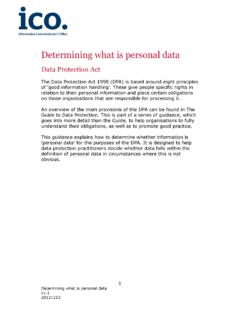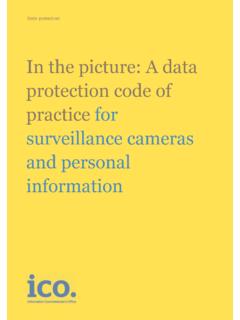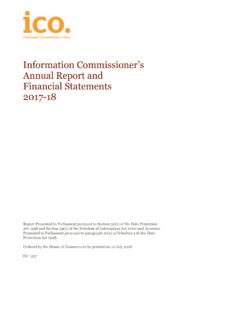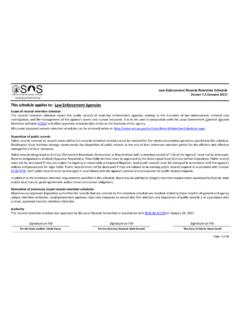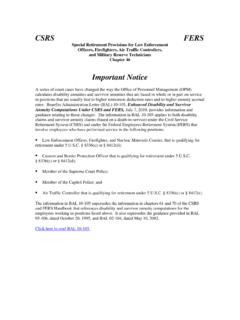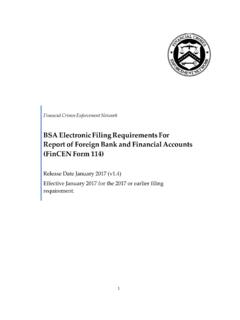Transcription of ICO lo Law enforcement (section 31)
1 Law enforcement (section 31) 20130529 Version: ICO lo Law enforcement (section 31) Freedom of Information Act Contents Introduction .. 2 Overview .. 2 What FOIA says .. 3 Sections 30 and 31 .. 6 The prejudice test .. 7 Sections 31(1)(a) (f) general law enforcement activities.. 8 Section 31(1)(a) the prevention or detection of crime .. 8 Mosaic and precedent effects .. 9 Section 31(1)(b) the apprehension or prosecution of offenders .. 10 Section 31(1)(c) the administration of justice .. 10 Section 31(1)(d) the assessment or collection of any tax or duty or any imposition of a similar nature .. 12 Section 31(1)(e) the operation of immigration controls .. 13 Section 31(1)(f) the maintenance of security and good order in prisons or other institutions where persons are lawfully detained .. 14 Sections 31(1)(g) (i) the exemptions by reference to section 31(2) .. 14 Section 31(1)(g) .. 15 Functions for a specified purpose.
2 15 For the purpose of ascertaining sections 31(2)(a) (e) .. 17 For the purpose of protecting charities sections 31(2)(f) (h) .. 23 For the purpose of health and safety sections 31(2)(i) (j) .. 23 Confidential sources .. 25 Sections 31(1)(h) and (i) .. 26 Neither confirm nor deny .. 26 The public interest 28 Protection from crime and its consequences .. 29 Prejudice to investigations .. 33 Voluntary supply of information .. 33 Public interest in favour of disclosure .. 34 Probity of investigations .. 35 Law enforcement (section 31) 20130529 Version: 2 Historical records .. 35 Other considerations .. 36 More information .. 37 Introduction 1. The Freedom of Information Act 2000 (FOIA) gives rights of public access to information held by public authorities. 2. An overview of the main provisions of FOIA can be found in The Guide to Freedom of Information. 3. This is part of a series of guidance, which goes into more detail than the Guide, to help public authorities to fully understand their obligations and promote good practice.
3 4. This guidance explains to public authorities how the exemption provided by section 31 protects the work of the law enforcement agencies and prevents information being disclosed that would increase the risk of the law being broken. Overview Section 31 provides a prejudice based exemption which protects a variety of law enforcement interests. It is closely linked to section 30. The exemption from the duty to communicate information can only be applied to information that is not exempt by virtue of section 30. The exemptions from the duty to confirm or deny are not mutually exclusive. Section 31 can be claimed by any public authority, not just those with law enforcement functions. For example, section 31(1)(a) prevention or detection of crime, can protect information on a public authority s systems which would make it more vulnerable to crime . It can also be used by a public authority that has no law enforcement function to protect the work of one that does.
4 When considering the prejudice test account should be taken of any mosaic and precedent effects. Law enforcement (section 31) 20130529 Version: 3 Sections 31(g) (i) are engaged by reference to section 31(2). For any of these exemptions to apply the public authority claiming them must be able to identify a public authority that has functions for one of the purposes specified in section 31(2) and that function must be prejudiced by the disclosure. Functions are the core functions of a public authority; they will normally be functions conferred by statute or, in the case of government departments by the Crown. The first five purposes described by section 31(2) all relate to a public authority s ability to ascertain something. This means the relevant public authority must have the responsibility to determine the issue with some certainty. Many of the purposes described by section 31(2) can involve investigations.
5 The information relating to confidential sources used in such investigations is protected not by section 31, but by section 30(2). There is a very strong public interest in protecting the law enforcement capabilities of public authorities. When considering the public interest in preventing crime it is important to take account of all the consequences that can be anticipated as realistic possibilities . What FOIA says 5. Section 31 states: 31. (1) Information which is not exempt information by virtue of section 30 is exempt information if its disclosure under this Act would, or would be likely to, prejudice - (a) the prevention or detection of crime, (b) the apprehension or prosecution of offenders, (c) the administration of justice, (d) the assessment or collection of any tax or duty or of Law enforcement (section 31) 20130529 Version: 4 any imposition of a similar nature, (e) the operation of immigration controls, (f) the maintenance of security and good order in prisons or in other institutions where persons are lawfully detained, (g) the exercise by any public authority of its functions for any of the purposes specified in subsection (2), (h) any civil proceedings which are brought by or on behalf of a public authority and arise out of an investigation conducted, for any purposes specified in subsection (2), by or on behalf of the authority by virtue of Her Majesty s prerogative or by virtue of powers conferred by or under an enactment, or (i) any inquiry held under the Fatal Accidents and Sudden Deaths Inquiries (Scotland) Act 1976 to the extent that the inquiry arises out of an investigation conducted, for any of the purposes specified in subsection (2)
6 , by or on behalf of the authority by virtue of Her Majesty s prerogative or by virtue of powers conferred by or under an enactment. (2) The purposes referred to in subsection (1)(g) to (i) are - (a) the purpose of ascertaining whether any person has failed to comply with the law, (b) the purpose of ascertaining whether any person is responsible for any conduct which is improper, (c) the purpose of ascertaining whether circumstances which would justify regulatory action in pursuance of any enactment exist or may arise, (d) the purpose of ascertaining a person s fitness or competence in relation to the management of bodies corporate or in relation to any profession or other activity which he is, or seeks to become, authorised to carry on, (e) the purpose of ascertaining the cause of an accident, Law enforcement (section 31) 20130529 Version: 5 (f) the purpose of protecting charities against misconduct or mismanagement (whether by trustees or other persons) in their administration, (g) the purpose of protecting the property of charities from loss or misapplication, (h) the purpose of recovering the property of charities, (i) the purpose of securing the health, safety and welfare of persons at work, and (j) the purpose of protecting persons other than persons at work against risk to health or safety arising out of or in connection with actions of persons at work.
7 (3) The duty to confirm or deny does not arise if, or to the extent that, compliance with section 1(1)(a) would, or would be likely to, prejudice any of the matters mentioned in subsection (1). 6. Section 31 is a prejudice based exemption and is subject to the public interest test. This means that not only does the information have to prejudice one of the purposes listed, but, before the information can be withheld, the public interest in preventing that prejudice must outweigh the public interest in disclosure. 7. The exemption is split into three main sections. Sections 31(1)(a) (f) provide protection for information which would prejudice, what will be referred to for the purposes of this guidance as, general law enforcement activities. Sections 31(1)(g) (i) are engaged by reference to a range of functions that public authorities carry out for the purposes listed in subsection 31(2). Section 31(3) provides an exemption from the duty to confirm or deny whether information is held.
8 8. The term law enforcement should be interpreted broadly. In the case of William Thomas Stevenson v the Information Commissioner and North Lancashire Teaching Primary Care Trust the Upper Tribunal commented that it is plain from reading the activities listed in (1) and the purposes specified in (2), that they include activities and purposes which go beyond actual law enforcement in the sense of taking civil or criminal or regulatory proceedings. They include a wide Law enforcement (section 31) 20130529 Version: 6 variety of activities which can be regarded as in aid of or related to the enforcement of (i) the criminal law, (ii) any regulatory regime established by statute, (iii) professional and other disciplinary codes, (iv) standards of fitness and competence for acting as a company director or other manager of a corporate body (v) aspects of law relating to charities and their property and (vi) standards of health and safety at work (paragraph 75).
9 Sections 30 and 31 9. Sections 30 and 31 are closely related. Although there are important differences in how they apply and who can use them, the two exemptions do complement each other. Together they protect information which, if disclosed, would undermine the work of law enforcement agencies or increase the risk of the law being broken. 10. The exemptions from the duty to communicate information provided by sections 31(1) and (2) can only be applied to information which is not exempt by virtue of section 30. This remains the case even if the public interest in relation to section 30 favours disclosure. Although the two exemptions cannot apply to the same piece of information, they could both be used in response to the same request as illustrated below. Example Following an incident in which fire arms officers arrested a gunman; the police received a request from a journalist seeking both the police s protocols for deploying armed officers and details of the actual arrest.
10 The protocol for deploying armed officers would be exempt under section 31 if the police could demonstrate that its disclosure would prejudice the prevention or detection of crime. The information relating to the actual arrest would be exempt under section 30. Even if section 30 could not be maintained after considering the public interest test, section 31 could still not be applied to the information on the arrests. 11. Although the exemptions from the duty to communicate information under sections 30 and 31 are mutually exclusive, the exemptions from the duty to confirm or deny are not; they can be applied to the same information. Law enforcement (section 31) 20130529 Version: 7 12. Section 30 can only be claimed by public authorities that have particular powers or duties whereas section 31 can be claimed by any public authority. They therefore complement each other because they can be used to protect the same information held by different public authorities.

